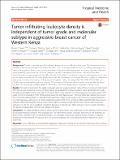| dc.contributor.author | Rispah T. Sawe, Simeon K. Mining, Ayub V. Ofulla, Kirtika Patel, Bernard Guyah, David Chumba, Jenifer R. Prosperi, Maggie Kerper, Zonggao Shi, Mayra Sandoval-Cooper, Katherine Taylor, Sunil Badve, M. Sharon Stack & Laurie E. Littlepage | |
| dc.date.accessioned | 2022-01-29T09:29:56Z | |
| dc.date.available | 2022-01-29T09:29:56Z | |
| dc.date.issued | 2017 | |
| dc.identifier.uri | https://repository.maseno.ac.ke/handle/123456789/4752 | |
| dc.description | DOI 10.1186/s41182-017-0059-4. | en_US |
| dc.description.abstract | Tumors commonly are infiltrated by leukocytes, or tumor infiltrating leukocytes (TILs). It remains unclear, however, if the density and type of individual TILs has a direct or simply correlative role in promoting poor prognosis in breast cancer patients. Breast cancer in Kenyan women is aggressive with presentation at a young age, with advanced grade (grade III), large tumor size (>2.0 cm), and poor prognosis. We previously observed that the tumors were predominantly estrogen receptor positive (ER+) but also included both a high percentage of triple negative tumors and also increased immune cell infiltration within the tumors. We used breast tumor tissues from each patient to make tissue microarrays that were then stained for leukocyte and myeloid markers including CD4, CD8, CD20, CD25, CD68, and CD163 using immunohistochemical techniques. The immune cell infiltration into the cancer tissue included increased numbers of macrophages (CD68+), helper T cells (CD4+), and CD25+ lymphocytes compared to benign tissue. | en_US |
| dc.publisher | Springer | en_US |
| dc.subject | Tumor infiltrating leukocytes (TILs), Aggressive breast cancer, Breast cancer subtypes, Advanced, African, Kenyan | en_US |
| dc.title | Tumor infiltrating leukocyte density is independent of tumor grade and molecular subtype in aggressive breast cancer of Western Kenya | en_US |
| dc.type | Article | en_US |

